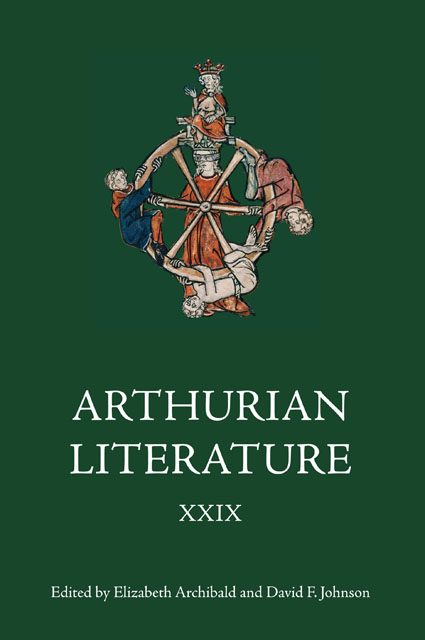Book contents
- Frontmatter
- Contents
- List of Illustrations
- General Editors’ Foreword
- List of Contributors
- I Edward III’s Abandoned Order of the Round Table
- II King Arthur’s Tomb at Glastonbury: The Relocation of 1368 in Context
- III Benedict of Gloucester’s Vita Sancti Dubricii: An Edition and Translation
- IV New Evidence for an Interest in Arthurian Literature in the Dutch Low Countries in the Fifteenth and Early Sixteenth Centuries
- V Malory’s Source-Manuscript for the First Tale of Le Morte Darthur
- VI Malory’s Sources – and Arthur’s Sisters – Revisited
- VII Peace, Justice and Retinue-Building in Malory’s ‘The Tale of Sir Gareth of Orkney’
- VIII Mapping Malory’s Morte: The (Physical) Place and (Narrative) Space of Cornwall
- IX The Fringes of Arthurian Fiction
- Contents of Previous Volumes
VII - Peace, Justice and Retinue-Building in Malory’s ‘The Tale of Sir Gareth of Orkney’
Published online by Cambridge University Press: 14 February 2023
- Frontmatter
- Contents
- List of Illustrations
- General Editors’ Foreword
- List of Contributors
- I Edward III’s Abandoned Order of the Round Table
- II King Arthur’s Tomb at Glastonbury: The Relocation of 1368 in Context
- III Benedict of Gloucester’s Vita Sancti Dubricii: An Edition and Translation
- IV New Evidence for an Interest in Arthurian Literature in the Dutch Low Countries in the Fifteenth and Early Sixteenth Centuries
- V Malory’s Source-Manuscript for the First Tale of Le Morte Darthur
- VI Malory’s Sources – and Arthur’s Sisters – Revisited
- VII Peace, Justice and Retinue-Building in Malory’s ‘The Tale of Sir Gareth of Orkney’
- VIII Mapping Malory’s Morte: The (Physical) Place and (Narrative) Space of Cornwall
- IX The Fringes of Arthurian Fiction
- Contents of Previous Volumes
Summary
Sir Thomas Malory’s ‘The Tale of Sir Gareth of Orkney’ (a tale in Le Morte Darthur, c. 1470) tells the story of Gareth, the youngest of the Orkney brothers, who seeks to prove himself worthy of knighthood through his knightly performances and not simply through his lineage. For this reason, young Gareth hides his identity for much of the romance. Because the youth refuses to reveal his name and lineage when he arrives at the Arthurian court, he is rudely nicknamed Bewmaynes (meaning ‘fair hands’) and is relegated to working in the kitchen – a rather unceremonious beginning to his knightly career. Nevertheless, when the damsel Lyonette arrives at court asking for a champion to rescue her besieged sister (who is later identified as Lyonesse), Gareth asks Arthur, ‘“that ye woll graunte me to have this adventure of this damesell, for hit belongyth unto me”’ (297.11–13). While readers are not initially sure what Gareth means when he declares that Lyonette’s quest ‘belongyth unto’ him at the outset of his adventures, they eventually do see how he is perfectly suited for this quest and ‘prove[s] himself a useful Arthurian knight’. By defeating thieves and murderers, freeing Lyonesse from the unchivalrous behaviour of the Red Knight of the Red Lands and subjugating other colour-coded knights who could potentially disrupt society, Gareth at once proves himself worthy of his status as a knight and signifies what type of knight he wishes to be – in this case, a governor of the people, which is a fitting social role for a youth auspiciously nicknamed Bewmaynes, since ‘fair hands are a “tokenyng of good gouernance”’ in the Middle Ages.
Thus, the foregrounding of Gareth’s battles for peace and justice (aspects of the knightly role of governing the people often represented in medieval chivalric texts) can be read as a reflection of the underlying apprehensions about poor governance during the social and political instability of the first half of the Wars of the Roses (roughly 1450–1470). The tale’s preoccupation with the governing duties of knights – specifically upholding justice and preserving the peace – reveals the uneasy relationships between peacekeeping, bastard feudalism and good governance that were being worked out in a variety of contemporary chivalric texts.
- Type
- Chapter
- Information
- Arthurian Literature XXIX , pp. 143 - 160Publisher: Boydell & BrewerPrint publication year: 2012

